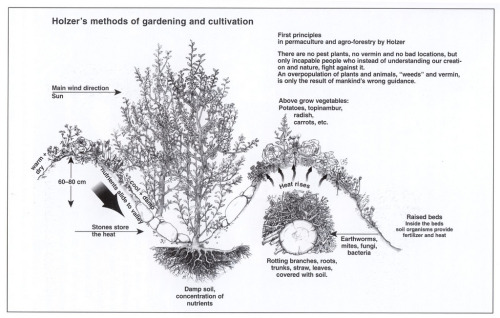#urban gardens
Hügelkultur (German, meaning “hill culture” or “mound culture”) is the garden concept of building raised beds over decaying wood piles. Decayed timbers become porous and retain moisture while releasing nutrients into the soil that, in turn, promote root growth in plant materials. As the logs decay, they expand and contract, creating air pockets that assist in aerating the soil, allowing roots to easily penetrate the soil. This decaying environment creates a beneficial home to earthworms. As the worms burrow into the soil, they loosen the soil and deposit nutrient-rich worm castings, beneficial to plants. An earthworm can produce its weight in castings on a daily basis.
The best decayed wood for a Hügelkultur, according to A Growing Culture, comes from alders, applewood, cottonwood, poplar, maple and birch. Use wood products that have been in the process of decay for about a year (using green, or fresh, wood products will rob the soil of necessary nitrogen). Some wood products, like cedar and black walnut, should be avoided because they produce organisms that negatively effect plant growth.
Read more at A Growing Culture.
Post link
Become a Biodynamic Gardener, and grow your own. Learn about “the buddy system” and “companion plantings” as well as composting and crop rotation. Certain plants benefit by growing near other plants: tall crops can provide a canopy for shorter crops; leeks will repel carrot flies; include flowering herbs and perennials to attract beneficial insects.
Illustration: Genevieve Simms
Post link
Herb Garden Design with Essential Fruits and Vegetables
Before planning an edible garden, think about the purpose of the garden first. These four window boxes were designed so that the client can easily open her windows and make a selection, or water everything from the convenience of her kitchen. We chose all my client’s favorite herbs and edible flowers: garlic chives, marigolds, parsley, several varieties of basil, creeping thyme, cilantro, and even a couple of strawberry plants.
Some herbs are also “perennials” and will last year round, while others (like basil) are seasonal. Group seasonal items together so that they are easily replaced with something else once their growing season is complete.
When replacing plants, don’t forget to replenish the soil, especially if you are planting in window boxes or containers. Valuable nutrients pass through containers quickly, so fresh soil amendments will ensure that the new plants get off to a great start.
Theme gardens are popular right now. Consider grouping herbs and vegetables together in a raised bed for cooking purposes. If you love Asian cooking, you might want to grow lemongrass, Thai basil, Vietnamese coriander, Chinese eggplant, and dwarf pepper plants (like ‘Baby Belle’). A great way to introduce children to the concept of gardening is to grow something they will also consume. Create a “Lemonade Garden” with all the plants you might use to make fresh lemonade: pineapple mint, orange mint, basil, cucumbers, and lemongrass. Plant a Meyer lemon tree, dwarf blueberry bushes, and strawberries in containers to complete the Lemonade Garden. Don’t forget to make ice cubes with the blueberries and strawberries for the lemonade.
Get creative. Did you know you can regrow many herbs and vegetables from your own garden, or re-root favorite edibles from the farmers market (celery and mint, for example)? Mother Earth Living provides a great how-to, HERE. Many of these can be started indoors on a sunny window ledge, and then transplanted outside after all danger of frost has passed.
Post link






